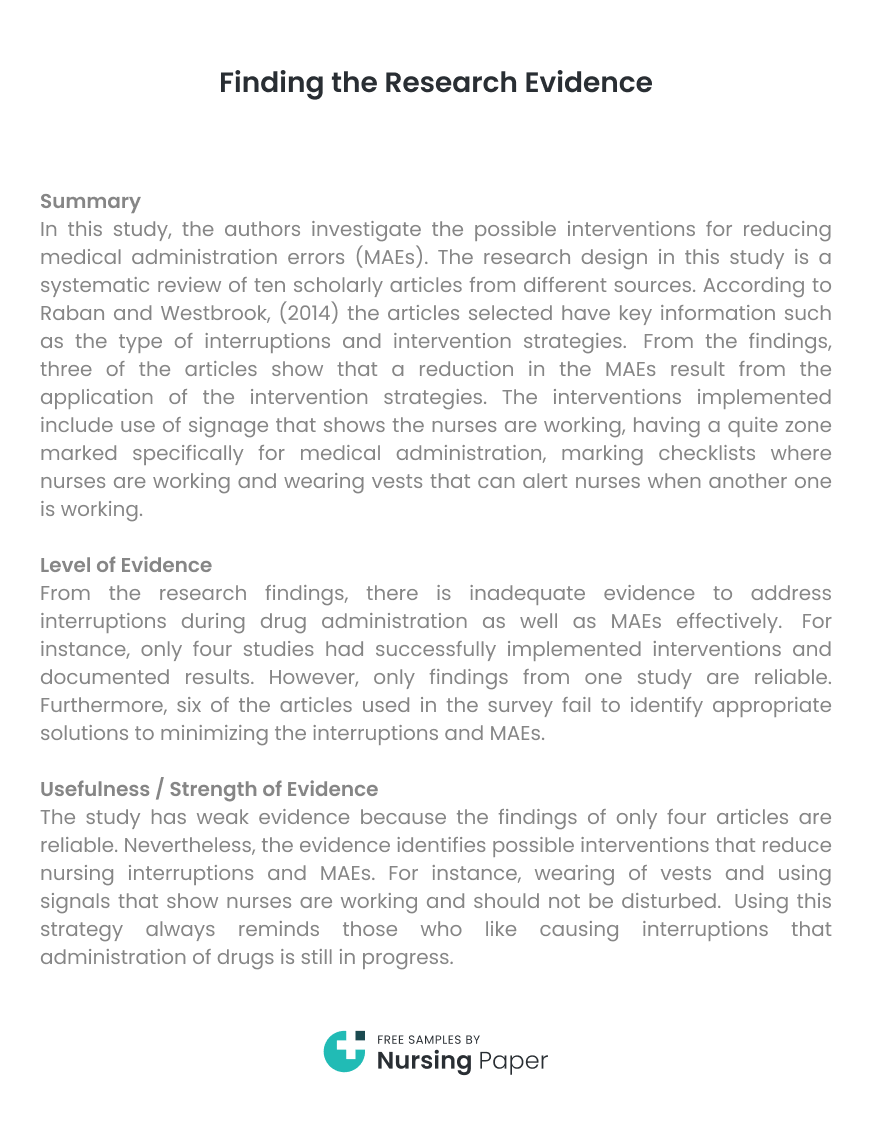
Finding the Research Evidence
Summary
In this study, the authors investigate the possible interventions for reducing medical administration errors (MAEs). The research design in this study is a systematic review of ten scholarly articles from different sources. According to Raban and Westbrook, (2014) the articles selected have key information such as the type of interruptions and intervention strategies. From the findings, three of the articles show that a reduction in the MAEs result from the application of the intervention strategies. The interventions implemented include use of signage that shows the nurses are working, having a quite zone marked specifically for medical administration, marking checklists where nurses are working and wearing vests that can alert nurses when another one is working.
Level of Evidence
From the research findings, there is inadequate evidence to address interruptions during drug administration as well as MAEs effectively. For instance, only four studies had successfully implemented interventions and documented results. However, only findings from one study are reliable. Furthermore, six of the articles used in the survey fail to identify appropriate solutions to minimizing the interruptions and MAEs.


Usefulness / Strength of Evidence
The study has weak evidence because the findings of only four articles are reliable. Nevertheless, the evidence identifies possible interventions that reduce nursing interruptions and MAEs. For instance, wearing of vests and using signals that show nurses are working and should not be disturbed. Using this strategy always reminds those who like causing interruptions that administration of drugs is still in progress.
Summary
This study investigates the use of drug round tabards as an effective intervention in reducing nursing interruptions and MAEs. The research methodology is observations of 313 medical administrations. The study involved two phases, pre-implementation that took two weeks and post-implementation that lasted for four months. The results were then analyzed through linear regression and descriptive statistics. The findings show that drug round tabards reduce interruptions and MAEs.
Level of Evidence
The study has a high level of evidence that drug round tabards minimize interruptions. From the study, nurses encounter several interruptions from their fellow nurses, patients, and visitors. For example, the interruptions reduced by 75%. Besides, the medication errors reduced by 66% (Verweij et al., 2014). Apparently, many people understand the information placed on the tabards. As indicated by (Scott et al., 2010), wearing tabards with words such as “Do Not Disturb” remind the people that nurses are attending to other patients.

Useful / Strengths of Evidence
The study has moderate but reliable evidence that use of drug round tabards reduces nursing interruptions and medical errors. According to Verweij et al. (2014), tabards with inscriptions remind people that the nurse is administering medication. Hence they should not disturb. The fact that drug round tabards reduce 75% of interruptions and 66% of medical errors, according to direct observations during this study, is enough proof that the intervention is effective.
1. Raban, M. Z., & Westbrook, J. I. (2014). Are interventions to reduce interruptions and errors during medication administration effective?: A systematic review. BMJ quality & safety, 23(5), 414-421.
2. Scott, J., Williams, D., Ingram, J., & Mackenzie, F. (2010). The effectiveness of drug round tabards in reducing the incidence of medication errors. Nursing times, 106(34), 13-15.
3. Verweij, L., Smeulers, M., Maaskant, J. M., & Vermeulen, H. (2014). Quiet, please! Drug round tabards: are they effective and accepted? A mixed method study. Journal of Nursing Scholarship, 46(5), 340-348.



The download will start shortly.

The download will start shortly.
 Subject:
Medicine
Subject:
Medicine  Number of pages: 3
Number of pages: 3  Subject:
Nursing
Subject:
Nursing  Number of pages: 6
Number of pages: 6  Subject:
Health and Social Care
Subject:
Health and Social Care  Number of pages: 2
Number of pages: 2  Subject:
Health and Social Care
Subject:
Health and Social Care  Number of pages: 3
Number of pages: 3  Subject:
Nursing
Subject:
Nursing  Number of pages: 2
Number of pages: 2  Subject:
Nursing
Subject:
Nursing  Number of pages: 3
Number of pages: 3  Subject:
Health and Social Care
Subject:
Health and Social Care  Number of pages: 2
Number of pages: 2  Subject:
Nursing
Subject:
Nursing  Number of pages: 2
Number of pages: 2  Subject:
Medicine
Subject:
Medicine  Number of pages: 1
Number of pages: 1  Subject:
Nursing
Subject:
Nursing  Number of pages: 9
Number of pages: 9  Subject:
Health and Social Care
Subject:
Health and Social Care  Number of pages: 9
Number of pages: 9  Subject:
Health and Social Care
Subject:
Health and Social Care  Number of pages: 2
Number of pages: 2  Subject:
Nursing
Subject:
Nursing  Number of pages: 7
Number of pages: 7  Subject:
Nursing
Subject:
Nursing  Number of pages: 7
Number of pages: 7  Subject:
Health and Social Care
Subject:
Health and Social Care  Number of pages: 2
Number of pages: 2 
